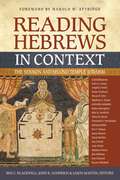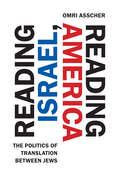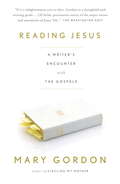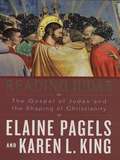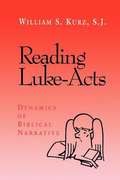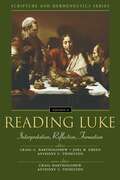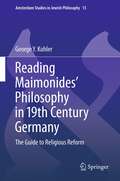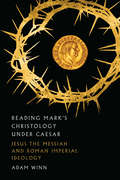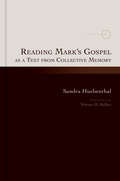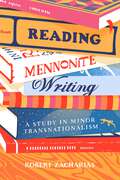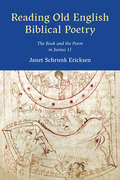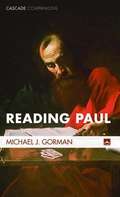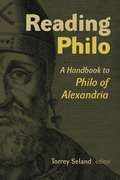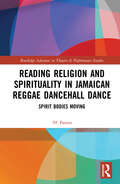- Table View
- List View
Reading Hebrews in Context: The Sermon and Second Temple Judaism
by ZondervanStudy Hebrews in its Second Temple ContextFollowing the proven model established in Reading Romans in Context, Reading Mark in Context, and Reading Revelation in Context, this book brings together a series of accessible essays that compare and contrast the theology and hermeneutical practices of the book of Hebrews with various early Jewish literature.Going beyond an introduction that merely surveys historical events and theological themes, this textbook examines individual passages in Second Temple Jewish literature in order to illuminate the ideas and emphases of Hebrews' varied discourses. Following the rhetorical progression of Hebrews, each chapter in this textbook:pairs a major unit of Hebrews with one or more sections of a thematically related Jewish textintroduces and explores the historical and theological nuances of the comparative textshows how the ideas in the comparative text illuminate those expressed in HebrewsIn addition to the focused comparison provided in the essays, Reading Hebrews in Context offers other student-friendly features that help them engage broader discussions, including an introductory chapter that familiarizes students with the world and texts of Second Temple Judaism and a glossary of important terms. The end of each chapter contains a list of other thematically-relevant Second Temple Jewish texts recommended for further study and a focused bibliography pointing students to critical editions and higher-level discussions in scholarly literature they might use to undertake their own comparative studies.
Reading Herzl in Beirut: The PLO Effort to Know the Enemy
by Jonathan Marc GribetzHow the Palestine Liberation Organization Research Center informed the PLO&’s relationship to Zionism and IsraelIn September 1982, the Israeli military invaded West Beirut and Israel-allied Lebanese militiamen massacred Palestinians in the Sabra and Shatila refugee camps. Meanwhile, Israeli forces also raided the Palestine Liberation Organization Research Center and trucked its complete library to Israel. Palestinian activists and supporters protested loudly to international organizations and the Western press, claiming that the assault on the Center proved that the Israelis sought to destroy not merely Palestinian militants but Palestinian culture as well. The protests succeeded: in November 1983, Israel returned the library as part of a prisoner exchange. What was in that library?Much of the expansive collection the PLO amassed consisted of books about Judaism, Zionism, and Israel. In Reading Herzl in Beirut, Jonathan Marc Gribetz tells the story of the PLO Research Center from its establishment in 1965 until its ultimate expulsion from Lebanon in 1983. Gribetz explores why the PLO invested in research about the Jews, what its researchers learned about Judaism and Zionism, and how the knowledge they acquired informed the PLO&’s relationship to Israel.
Reading Illegitimacy in Early Iberian Literature (The New Middle Ages)
by Geraldine HazbunReading Illegitimacy in Early Iberian Literature presents illegitimacy as a fluid, creative, and negotiable concept in early literature which challenges society’s definition of what is acceptable. Through the medieval epic poems Cantar de Mio Cid and Mocedades de Rodrigo, the ballad tradition, Cervantes’s Novelas ejemplares, and Lope de Vega’s theatre, Geraldine Hazbun demonstrates that illegitimacy and legitimacy are interconnected and flexible categories defined in relation to marriage, sex, bodies, ethnicity, religion, lineage, and legacy. Both categories are subject to the uncertainties and freedoms of language and fiction and frequently constructed around axes of quantity and completeness. These literary texts, covering a range of illegitimate figures, some with an historical basis, demonstrate that truth, propriety, and standards of behaviour are not forged in the law code or the pulpit but in literature’s fluid system of producing meaning.
Reading Israel, Reading America: The Politics of Translation between Jews (Stanford Studies in Jewish History and Culture)
by Omri AsscherAmerican and Israeli Jews have historically clashed over the contours of Jewish identity, and their experience of modern Jewish life has been radically different. As Philip Roth put it, they are the "heirs jointly of a drastically bifurcated legacy." But what happens when the encounter between American and Israeli Jewishness takes place in literary form—when Jewish American novels make aliyah, or when Israeli novels are imported for consumption by the diaspora? Reading Israel, Reading America explores the politics of translation as it shapes the understandings and misunderstandings of Israeli literature in the United States and American Jewish literature in Israel. Engaging in close readings of translations of iconic novels by the likes of Philip Roth, Saul Bellow, Bernard Malamud, Amos Oz, A. B. Yehoshua, and Yoram Kaniuk—in particular, the ideologically motivated omissions and additions in the translations, and the works' reception by reviewers and public intellectuals—Asscher decodes the literary encounter between Israeli and American Jews. These discrepancies demarcate an ongoing cultural dialogue around representations of violence, ethics, Zionism, diaspora, and the boundaries between Jews and non-Jews. Navigating the disputes between these "rival siblings" of the Jewish world, Asscher provocatively untangles the cultural relations between Israeli and American Jews.
Reading Jesus's Bible: How the New Testament Helps Us Understand the Old Testament
by John GoldingayFor Jesus and his contemporaries, what we now know as the Old Testament was simply the Scriptures—and it was the fundamental basis of how people understood their relationship with God. In this book John Goldingay uncovers five major ways in which the New Testament uses the Old Testament. His discussion paves the way for contemporary readers to understand and appreciate the Old Testament more fully. Along with an overview of how Jesus and the first Christian writers read the Old Testament, illustrated with passages from Matthew, Romans, 1 Corinthians, and Hebrews, Goldingay offers a straightforward introduction to the Old Testament in its own right. Reading Jesus's Bible will shed fresh Old Testament light on Jesus, God, and the church for readers today.
Reading Jesus's Bible: How the New Testament Helps Us Understand the Old Testament
by John GoldingayFor Jesus and his contemporaries, what we now know as the Old Testament was simply the Scriptures—and it was the fundamental basis of how people understood their relationship with God. In this book John Goldingay uncovers five major ways in which the New Testament uses the Old Testament. His discussion paves the way for contemporary readers to understand and appreciate the Old Testament more fully. Along with an overview of how Jesus and the first Christian writers read the Old Testament, illustrated with passages from Matthew, Romans, 1 Corinthians, and Hebrews, Goldingay offers a straightforward introduction to the Old Testament in its own right. Reading Jesus's Bible will shed fresh Old Testament light on Jesus, God, and the church for readers today.
Reading Jesus: A Writer's Encounter with the Gospels
by Mary GordonReading Jesus is a personal journey through the fundamental Biblical stories. As celebrated author Mary Gordon ponders the intense strangeness of a deity in human form, unresolved moral ambiguities within the text, and the problem posed to her as an enlightened reader by the miracle of the Resurrection. What she rediscovers--and reinterprets with her signature candor, intelligence, and straightforwardness--is a rich store of overlapping, sometimes conflicting teachings that feel both familiar and tantalizingly elusive.
Reading Jewish Religious Texts (Reading Religious Texts)
by Eliezer SegalReading Jewish Religious Texts introduces students to a range of significant post-biblical Jewish writing. It covers diverse genres such as prayer and liturgical poetry, biblical interpretation, religious law, philosophy, mysticism and works of ethical instruction. Each text is newly translated into English and accompanied by a detailed explanation to help clarify the concepts and arguments. The commentary also situates the work within its broader historical and ideological context, giving readers an enhanced appreciation of its place in the Jewish religious experience. This volume includes a comprehensive timeline, glossary and bibliography.
Reading John for Dear Life: A Spiritual Walk With The Fourth Gospel
by Jaime Clark-SolesJaime Clark-Soles takes readers on a dynamic journey deep into the heart of John in this lively reading of the Fourth Gospel. This book is not simply a commentary but a spiritual companion to be read alongside the Bible. Clark-Soles provides important historical and literary insights while illuminating the dramatic characters in John and emphasizing the Gospel's unique themes and symbols. Her engaging writing style will generate enthusiasm and investment in John's message. Readers will also appreciate the addition of prayers as well as questions for individual study and/or group discussion. This excellent guide will enrich our spiritual journeys while opening ourselves up to Jesus through the words, stories, questions, symbols, and characters we encounter in John's Gospel.
Reading Judas
by Elaine Pagels Karen L. KingDiscover the true meaning of the infamous lost Gospel of Judas . . . Lost for 1,600 years, the Gospel of Judas has only now had its meaning unlocked for readers today, causing worldwide controversy with its startling claim that not only did Jesus ask Judas to betray him, but also that Judas was killed by the other disciples. Was Judas a betrayer or a loyal disciple? Did he write this shocking document? And what does it mean for us today? In Reading Judas Elaine Pagels and Karen L. King, world-renowned experts in religious texts, explore the meanings of this contentious gospel in detail, separating myth from fact. Here they reveal a gospel that, far from seeing Jesus' death as a sacrifice for humanity's sins, opposes the idea of martyrdom and instead points towards a faith that is free from authority. Containing the first translation of the Gospel of Judas from the original Coptic, Reading Judas radically overthrows our notions of the Christian faith.
Reading Luke-Acts: Dynamics of Biblical Narrative
by William S. KurzThis book shows how literary criticism illuminates the Gospel of Luke and the Acts of the Apostles, reclaiming them as biblical narrative. William Kurz explores literary aspects such as implied authors or readers, plot, and assumed information, or gaps. He then highlights the role of the narrator, who is the primary key to the focus and perspective of the narrative. Kurz also discovers an implicit commentary in Luke--Acts. Finally, he traces the implications of reading Luke--Acts as canonical Scripture and the merits of literary methods.
Reading Luke: A Literary and Theological Commentary
by Charles H. TalbertReading Luke concentrates on the literary and theological distinctives of the third Gospel. Charles Talbert's effective and insightful commentary enables its reader to see and feel the full force of the literary masterpiece that begins the Christian story in the birth of Jesus Christ and continues in the Acts of the Apostles. Reading Luke is an essential book for students and ministers studying Luke-Acts.
Reading Luke: Interpretation, Reflection, Formation (Scripture and Hermeneutics Series)
by ZondervanA rich and comprehensive volume—essential reading for all those interested in how to read Luke as relevant for today In this sixth volume, the Scripture and Hermeneutics Seminar brings its past six years of work on biblical hermeneutics to bear on the gospel according to Luke. In his introduction, Anthony Thiselton, world authority on biblical hermeneutics, sets the context for a wideranging exploration of how to read Luke for God&’s address today. Traditional and more contemporary approaches are brought into dialogue with each other as several top Lukan scholars reflect on how best to read Luke as Scripture. Topics covered include the purpose of Luke- Acts, biblical theology and Luke, narrative and Luke, reception history and Luke, the parables in Luke, a missional reading of Luke, and theological interpretation of Luke. Since prayer is a major theme in Luke, this volume explores not only the role of prayer in Luke, but also the relationship between prayer and exegesis.
Reading Maimonides' Philosophy in 19th Century Germany
by George Y. KohlerThis book investigates the re-discovery of Maimonides' Guide of the Perplexed by the Wissenschaft des Judentums movement in Germany of the nineteenth and beginning twentieth Germany. Since this movement is inseparably connected with religious reforms that took place at about the same time, it shall be demonstrated how the Reform Movement in Judaism used the Guide for its own agenda of historizing, rationalizing and finally turning Judaism into a philosophical enterprise of 'ethical monotheism'. The study follows the reception of Maimonidean thought, and the Guide specifically, through the nineteenth century, from the first beginnings of early reformers in 1810 and their reading of Maimonides to the development of a sophisticated reform-theology, based on Maimonides, in the writings of Hermann Cohen more then a hundred years later.
Reading Mark in Context: Jesus and Second Temple Judaism
by N. T. Wright John K. Goodrich Ben C. Blackwell Jason MastonOver the last several decades, the Jewishness of Jesus has been at the forefront of scholarship and students of the New Testament are more than ever aware of the importance of understanding Jesus and the Gospels in their Jewish context. Reading Mark in Context helps students see the contour and texture of Jesus' engagement with his Jewish environment. It brings together a series of accessible essays that compare and contrast viewpoints, theologies, and hermeneutical practices of Mark and his various Jewish contemporaries.Going beyond an introduction that merely surveys historical events and theological themes, this textbook examines individual passages in Second Temple Jewish literature in order to illuminate the context of Mark's theology and the nuances of his thinking. Following the narrative progression of Mark's Gospel, each chapter in this textbook (1) pairs a major unit of the Gospel with one or more sections of a thematically-related Jewish text, (2) introduces and explores the historical and theological nuances of the comparative text, and (3) shows how the ideas in the comparative text illuminate those expressed in Mark.
Reading Mark's Christology Under Caesar: Jesus the Messiah and Roman Imperial Ideology
by Adam Winn“Christ or Caesar?"
Reading Mark's Gospel as a Text from Collective Memory
by Sandra HuebenthalHow did the Gospel of Mark come to exist? And how was the memory of Jesus shaped by the experiences of the earliest Christians? For centuries, biblical scholars examined texts as history, literature, theology, or even as story. Curiously absent, however, has been attention to processes of collective memory in the creation of biblical texts. Drawing on modern explorations of social memory, Sandra Huebenthal presents a model for reading biblical texts as collective memories. She demonstrates that the Gospel of Mark is a text evolving from collective narrative memory based on recollections of Jesus&’s life and teachings. Huebenthal investigates the principles and structures of how groups remember and how their memory is structured and presented. In the case of Mark&’s Gospel, this includes examining which image of Jesus, as well as which authorial self-image, this text as memory constructs. Reading Mark&’s Gospel as a Text from Collective Memory serves less as a key to unlock questions about the historical Jesus and more as an examination of memory about him within a particular community, providing a new and important framework for interpreting the earliest canonical gospel in context.
Reading Mark's Gospel as a Text from Collective Memory: A Text From Community Memory
by Sandra HuebenthalHow did the Gospel of Mark come to exist? And how was the memory of Jesus shaped by the experiences of the earliest Christians? For centuries, biblical scholars examined texts as history, literature, theology, or even as story. Curiously absent, however, has been attention to processes of collective memory in the creation of biblical texts. Drawing on modern explorations of social memory, Sandra Huebenthal presents a model for reading biblical texts as collective memories. She demonstrates that the Gospel of Mark is a text evolving from collective narrative memory based on recollections of Jesus&’s life and teachings. Huebenthal investigates the principles and structures of how groups remember and how their memory is structured and presented. In the case of Mark&’s Gospel, this includes examining which image of Jesus, as well as which authorial self-image, this text as memory constructs. Reading Mark&’s Gospel as a Text from Collective Memory serves less as a key to unlock questions about the historical Jesus and more as an examination of memory about him within a particular community, providing a new and important framework for interpreting the earliest canonical gospel in context.
Reading Mennonite Writing: A Study in Minor Transnationalism
by Robert ZachariasMennonite literature has long been viewed as an expression of community identity. However, scholars in Mennonite literary studies have urged a reconsideration of the field’s past and a reconceptualization of its future. This is exactly what Reading Mennonite Writing does.Drawing on the transnational turn in literary studies, Robert Zacharias positions Mennonite literature in North America as "a mode of circulation and reading" rather than an expression of a distinct community. He tests this reframing with a series of methodological experiments that open new avenues of critical engagement with the field’s unique configuration of faith-based intercultural difference. These include cross-sectional readings in nonnarrative literary history, archival readings of transatlantic multilingual diaries, Canadian rewritings of Latin American film’s deployment of Mennonite theology as fantasy, an examination of the fetishistic structure of ethnicity as a "thing" that has enabled Mennonite identity to function in a post-identity age, and, finally, a tentative reinvestment in ideals of Mennonite community via the surprising routes of queerness and speculative fiction. In so doing, Zacharias presents Mennonite fiction, poetry, and film criticism in North America as a useful case study in the shifting position of minor literatures in the wake of the transnational turn.Theoretically sophisticated, this study of minor transnationalism will appeal to specialists in Mennonite literature and to scholars working in the broader field of transnational literary studies.
Reading Mennonite Writing: A Study in Minor Transnationalism
by Robert ZachariasMennonite literature has long been viewed as an expression of community identity. However, scholars in Mennonite literary studies have urged a reconsideration of the field’s past and a reconceptualization of its future. This is exactly what Reading Mennonite Writing does.Drawing on the transnational turn in literary studies, Robert Zacharias positions Mennonite literature in North America as “a mode of circulation and reading” rather than an expression of a distinct community. He tests this reframing with a series of methodological experiments that open new avenues of critical engagement with the field’s unique configuration of faith-based intercultural difference. These include cross-sectional readings in nonnarrative literary history; archival readings of transatlantic life writing; Canadian rewritings of Mexican film’s deployment of Mennonite theology as fantasy; an examination of the fetishistic structure of ethnicity as a “thing” that has enabled Mennonite identity to function in a post-identity age; and, finally, a tentative reinvestment in ideals of Mennonite community via the surprising routes of queerness and speculative fiction. In so doing, Zacharias reads Mennonite writing in North America as a useful case study in the shifting position of minor literatures in the wake of the transnational turn.Theoretically sophisticated, this study of minor transnationalism will appeal to specialists in Mennonite literature and to scholars working in the broader field of transnational literary studies.
Reading Old English Biblical Poetry: The Book and the Poem in Junius 11 (Toronto Anglo-Saxon Series)
by Janet Schrunk EricksenReading Old English Biblical Poetry considers the Junius 11 manuscript, the only surviving illustrated book of Old English poetry, in terms of its earliest readers and their multiple strategies of reading and makingmeaning. Junius 11 begins with the Creation story and ends with the final vanquishing of Satan by Jesus. The study is framed by particular attention to the materiality of the manuscript and how that might have informed its early reception, and it broadens considerations of reading beyond those of the manuscript’s compiler and possible patron. As a book, Junius 11 reflects a rich and varied culture of reading that existed in and beyond houses of God in England in the tenth and eleventh centuries, and it points to readers who had enough experience to select and find wisdom, narrative pleasure, and a diversity of other things within this orany book’s contents.
Reading Paul
by Michael J. GormanGorman places special emphasis on the political character of Paul's gospel and on the themes of cross and resurrection, multiculturalism in the church, and peacemaking and nonviolence as the way of Christ according to Paul. Gorman also offers a distinctive interpretation of justification by faith as participation in Christ--an interpretation that challenges standard approaches to these Pauline themes.
Reading Paul with the Reformers: Reconciling Old and New Perspectives
by Stephen J. ChesterIn debates surrounding the New Perspective on Paul, the sixteenth-century Protestant Reformers are often characterized as the apostle&’s misinterpreters-in-chief. In this book Stephen Chester challenges that conception with a careful and nuanced reading of the Reformers&’ Pauline exegesis. Examining the overall contours of Reformation exegesis of Paul, Chester contrasts the Reformers with their opponents and explores particular contributions made by such key figures as Luther, Melanchthon, and Calvin. He relates their insights to contemporary debates in Pauline theology about justification, union with Christ, and other central themes, arguing that their work remains a significant resource today. Published in the 500th anniversary year of the Protestant Reformation, Chester&’s Reading Paul with the Reformers reclaims a robust understanding of how the Reformers actually read the apostle Paul.
Reading Philo: A Handbook to Philo of Alexandria
by Torrey SelandGuidebook par excellence to a significant ancient Jewish scholar A contemporary of both Jesus and the apostle Paul, Philo was a prolific Jewish theologian, philosopher, and politician -- a fascinating, somewhat enigmatic figure -- who lived his entire life in Alexandria, Egypt. His many books are important sources for our understanding of ancient Judaism, early Christianity, and the philosophical currents of that time.Reading Philo is an excellent introductory guide to Philo’s work and significance. The contributors -- all well-known experts on Philo of Alexandria -- discuss Philo in context, offer methodological considerations (how best to study Philo), and explore Philo’s ongoing relevance and value (why reading him is important). This practical volume will be an indispensable resource for anyone delving into Philo and his world.
Reading Religion and Spirituality in Jamaican Reggae Dancehall Dance: Spirit Bodies Moving (Routledge Advances in Theatre & Performance Studies)
by 'H' PattenThis book explores the genealogy of Jamaican dancehall while questioning whether dancehall has a spiritual underscoring, foregrounding dance, and cultural expression. This study identifies the performance and performative (behavioural actions) that may be considered as representing spiritual ritual practices within the reggae/dancehall dance phenomenon. It does so by juxtaposing reggae/dancehall against Jamaican African/neo-African spiritual practices such as Jonkonnu masquerade, Revivalism and Kumina, alongside Christianity and post-modern holistic spiritual approaches. This book will be of great interest to students and scholars in performance studies, popular culture, music, theology, cultural studies, Jamaican/Caribbean culture, and dance specialists.
